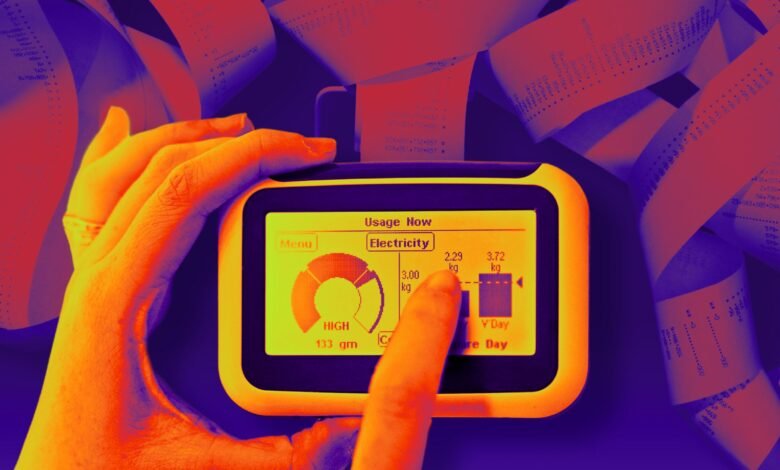Energy Bills Are Too High. 32% of US Adults Rely on Credit or Payment Plans to Cover Costs, CNET Survey Finds

This summer’s heat is already breaking records, and our latest survey shows that most Americans are feeling the burn from their rising energy bills.
An exclusive CNET Money survey found that 78% of US adults are concerned about their home energy bills this summer, and 32% are using financing options, like credit cards, loans or payment plans to get by.
I’m not surprised by the data. Last month, I reported that 93% of Americans are worried about inflation, and 41% said high utility bills had the biggest sticker shock.
Yes, energy costs are high. Even though my energy bill has remained the same (thanks to energy-efficient upgrades), my mother, who lives in a smaller but older home in the same state, pays nearly twice as much for her energy bill in the summer.
Daniella Flores, a personal finance expert and CNET Money Expert Review Board member, also isn’t shocked by the survey results, and has heard people are worried their energy bills will get even more expensive. Despite small dips in average energy costs over the past two months, the latest Consumer Price Index report shows that energy costs have risen 4.7% since May 2023. When energy company costs go up, so do ours, said Flores.
Concerns about the direction of the economy still linger, including increases in everyday costs and energy use on a planet that’s warming. It may seem like expensive energy bills are here to stay and there’s not much you can do to lower the cost. But there are steps you can take. Here’s a breakdown of what CNET uncovered in our latest survey and expert tips on how to save energy and money.
What to know
- Rising energy costs have affected the finances of most US adults, mainly in the South and Northeast.
- Of those whose finances have been impacted, nearly 3 in 4 plan to take (or have taken) some sort of action to help lower energy costs. The majority are cutting back on essential and nonessential spending. 21% are relying on borrowing, while 19% are using payment plans or payment assistance programs.
- 35% of US adults in the Northeast are more concerned about their home energy costs this summer compared to last summer.
- 32% of US adults are concerned about the cost of energy-efficiency projects, such as upgrading the HVAC system or installing solar panels.
Home energy bill concerns are growing nationwide
CNET survey data reveals home energy costs are affecting household finances. Interestingly, we found there isn’t much variance by region. “Concerns about energy costs aren’t limited to one part of the country or to a few expensive states. These concerns are being felt similarly all across the country,” said CNET Senior Editor Jon Reed, a home energy and renewables expert.
CNET ranked the top 10 states with the highest electricity bills and found a similar trend that energy costs — specifically electricity — aren’t a regional issue. The top 10 states with the highest average electricity bills are Connecticut, Hawaii, Massachusetts, Rhode Island, Maryland, Tennessee, West Virginia, Alabama, Alaska and Maine. The top 10’s average monthly electric bills range from $160 to $202 — well above the national average of $135.
Even more interesting, only six out of the top 10 are also states with the highest electricity rates. California, New York, New Hampshire, Vermont and Michigan have some of the highest electric rates in the US, but not the highest electric bills.
Most Americans are struggling to pay rising energy bills
As energy costs rise, fitting this unpredictable expense into your budget can be difficult. Most US adults have a plan to tackle high energy bills, but an alarming 32% of US adults are leaning on borrowing, payment plans or assistance programs to afford their energy bills, according to this survey. Similarly, 24% of participants said they are cutting back on essential purchases to find room in their budgets for energy bills.
Others are cutting back on nonessential spending (39%), dipping into savings (15%) and increasing their income (13%).
Using credit cards may seem like the next best solution if you can’t afford to pay your energy bill. But paying for your energy bills with a credit card can be costly in different ways. Not only can this lead to interest and debt if you can’t pay the balance back in full, but some energy companies charge a processing fee when you use a credit card to pay your bill.
Options if you’re struggling to afford your energy bill
Utility-approved payment plan: If you can’t afford your monthly energy bill without leaning on credit, Flores and Kanj both recommend contacting your utility companies to see if you qualify for a payment plan. A utility-approved payment plan can help you pay off your balance in installments over a set period of time. While payment plans help if you are behind on paying off your bill, it won’t solve the long-term problem of affordable energy costs.
Low Income Home Energy Assistance Program: You may also qualify for LIHEAP, a federally funded utility bill assistance program. LIHEAP may ease the burden of heating and cooling costs with bill pay assistance, home weatherization repairs or energy crisis help. For more information, you can visit the Office of Community Services website, brochure, email the National Energy Assistance Referral service at energy@ncat.org or call 1-866-NRG-NEAR.
Budget billing: If it’s predictability you seek, many utility companies offer budget billing plans. Also known as level billing or average billing, depending on your utility company, budget billing will even out your monthly energy bill versus a fluctuating one based on your seasonal consumption patterns. If enrolled, your utility will use your previous energy usage profile and predict your next 12 months of billing and divide it by 12 months. Under budget billing, your monthly bill will be the same amount each month. If you go over the expected amount at the end of your agreement, you’ll pay the difference. But if you pay for more energy than you use, you’ll see a credit.
“If you have an older home, your electricity bill might be a lot more expensive in the summer than it is for the winter,” said Kanj. “These plans can even out your bill over the full 12 months so that you have a more predictable monthly payment.”
Expert tips for saving money on your energy bills
The majority of survey respondents (70%) said they are making an effort to be energy efficient. Most are incorporating energy-efficient products, but a smaller percentage are taking on more expensive projects such as upgrading their HVAC system to a more efficient one or installing solar panels.
Here’s what homeowners and renters say they are doing to reduce energy costs, and expert advice to lower your bill even more.
Shop for energy-efficient products
According to the survey, 44% of participants use energy-efficient products such as smart light bulbs, plugs and thermostats.
Switching to smart products like these can be effective, said Wael Kanj, a senior research associate at Rewiring America, a nonprofit that supports electrification efforts. Energy-efficient products can help lower your energy bill and improve your heating and cooling system’s efficiency. They’re small upgrades that can be less daunting to take on than major renovations, said Kanj.
Flores and their wife live in Washington state and have made energy upgrades, like installing a more efficient air conditioning unit in their home. To save even more money, Flores turns the unit off or raises the temperature setting when they can. They also run ceiling fans to help circulate the air. Despite their best efforts, even the cost of maintaining efficient appliances is getting more expensive.
“The largest part of our energy bill seems to be our heating and cooling,” said Flores. “Our AC bill is going up summer to summer, year over year because it’s getting hotter and drier every summer.”
Monitor your thermostat temperature
If you rent or can’t afford smart home tech upgrades right now, Kanj says there are other small steps you can take to lower your energy bills. If a smart thermostat isn’t in the cards right now, try adjusting your thermostat before you leave home to lower costs. 78 degrees is the ideal temperature to set your thermostat to during the summer to save money, according to Energy Star, a program of the US Environmental Protection Agency and the US Department of Energy. During the winter, the federal program recommends setting your thermostat to 68 degrees.
Participate in a virtual power plant
A virtual power plant is a new power distribution model where an energy operation — like a utility — can control how you use your energy or tap into your stored energy. VPP programs in the US are voluntary and aim to relieve the power grid at times of peak demand. Only 3% of survey respondents say they participate in a virtual power plant program. Reed said that number should rise quickly as more utility companies experiment with ways consumers can help the power grid — and find more incentives for these programs.
The benefit of VPP participation is the bill credits in exchange for allowing your utility company — or another third party — to leverage your home’s energy technology when the electric grid is overwhelmed. A few common examples are solar batteries, backup battery storage or smart thermostats. When the grid is stressed and by allowing your utility access to your thermostat, for example, it can remotely adjust your home’s temperature in exchange for bill credits.
Insulate and weatherize windows and doors
Only 16% of US adults are insulating their home to improve energy efficiency, the survey reveals. But it’s the one tip Kanj recommends the most.
Insulating your home is a good first step. If your home isn’t well-insulated, you’ll likely spend more on your heating and cooling bills because you’re sending your energy (and money) out the door, he added.
How can you tell if the insulation around your windows and doors is working? Check to see if you can feel air escaping through cracks. You can pick up insulation kits and weather stripping at your local hardware store to seal up areas around your home where air is leaking. If you already have insulation installed, make sure it’s still intact and not worn out. To further boost your efforts, add insulated window treatments, such as blinds and curtains, to keep your home cooler in the summer and warmer in the winter.
Check to see if you live in a deregulated area
If your energy provider’s costs have skyrocketed, you may be able to shop around for a new company or energy plan, depending on where you live. First, check if you live in a deregulated state — also known as an energy choice market. If so, you can compare electricity rates, plans and providers to see if you could be saving money. You might also choose a fixed-rate energy plan, which can provide you with stability and predictability for your gas or electric bills.
It’s not always easy to figure out how much you’re paying, so make sure you understand how to read your energy bill and contact your provider if you have any questions.
Consider a solar panel investment
A solar panel investment can help offset some or all of your electricity costs. But it usually comes with a hefty upfront investment in the ballpark of $15,000 to $50,000 based on factors like how many panels you need and where you live. Experts agree, though, that solar panels do eventually pay for themselves. The average payback period is about six to 12 years, CNET contributor Mike De Socio reported last year. After the payback period, all the energy solar panels produce is essentially free.
Adding a solar battery is another expensive option that can cost around another $10,000. But a solar battery can store excess energy from your panels at night when they aren’t producing energy. It can even sell stored energy back to your utility company for bill credits, if your provider has a generous net metering program.
If your home isn’t a good candidate for solar panels because of shade or cost, see if community solar is an option in your area. Community solar programs let you buy into a power plan that’s connected to a solar farm in your area, Kanj added.
Read more: 7 Questions to Ask an Energy Provider Before Signing Up
How to save on energy efficient upgrades
Despite most US adults trying to be energy efficient, they’re also concerned about the costs. According to the survey, 32% of US adults worry about the expense of energy efficiency projects, while 29% question whether making changes will actually help them save money.
Kanj acknowledges that cost is a big factor for many people, but says that upgrading your HVAC system or replacing it with a heat pump — a big home renovation 14% of our survey participants said they were tackling — can make a big difference in your bill for decades to come.
Reed, who also reports on heat pumps for CNET and witnessed first-hand how they operate at CES, said they can serve a dual purpose — working as an all-electric and energy-efficient alternative to a furnace and an air conditioner.
“The Inflation Reduction Act created like an electric bank account for every household where they have access to money that they can use to make these upgrades and bring the cost of these electrical appliances down,” said Kanj.
If you’re considering making energy efficient upgrades to your home, make sure you look into the tax credits and rebates you’re eligible for, such as the residential clean energy credit and the energy efficient home improvement credit. Many states offer their own credits, too.
Rewiring America also has a savings calculator you can use to find out how much you could save with eligible tax credits and state-level rebates after you enter some household information. If you’re feeling overwhelmed and not sure where to start, Kanj recommends scheduling a home energy audit, which is an in-person walk-through of your home with a contractor who will show you more energy-efficient solutions you could make to cut costs. That way, you’ll have a plan of options and can choose what fits in your long- and short-term goals, added Kanj.
Recommended Articles
Source link




